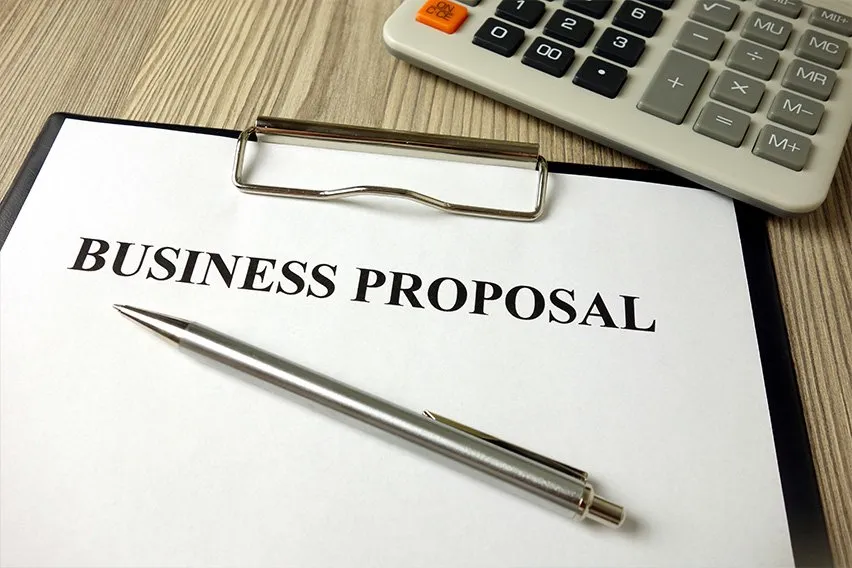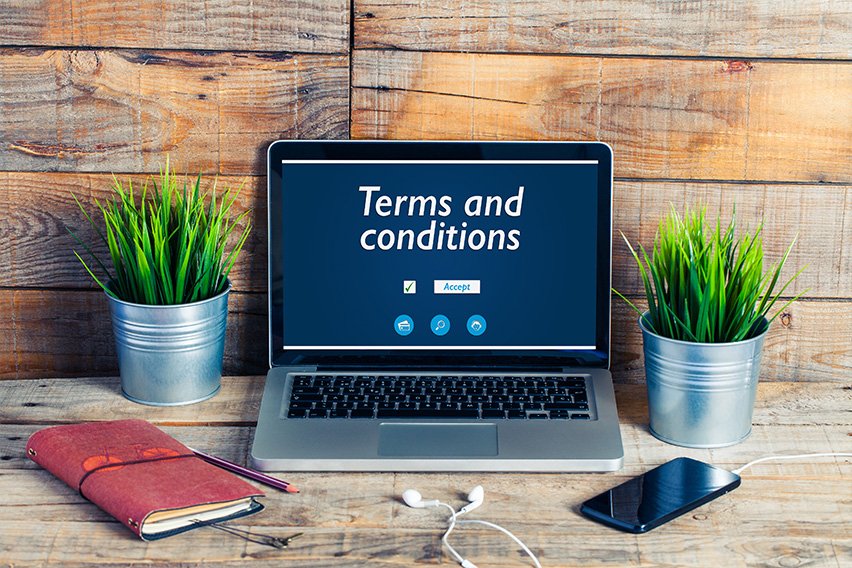7 Simple Steps to Write a Business Proposal | A Guide for Small Businesses

Why would your small business need to write a proposal? Government agencies and big companies may require you to submit one in response to their request for proposal (RFP). Or a new client could want an in-depth look at why you’re the right business for the job.
Whatever the case, writing powerful proposals helps small businesses win jobs in today’s competitive business environment, according to Entrepreneur.
Confused about what a business proposal (also known as a “project proposal”) is? This article has an easy-to-understand definition.
In this article, we’ll cover:
- Get a Template
- Understand the Requirements
- Talk to the Client
- Brainstorm Solutions
- Sell Your Value
- Fill out the Details
- Review and Revise
1. Get a Template
A business proposal template helps you create a professional-looking, detailed proposal. Proposals generally have the same format, though there may be specific requirements depending on what industry you’re in, according to Inc..
Microsoft Office has free proposal templates for service-based businesses (Word) and another for construction contractors (Excel).
Or take your proposals to the next step. FreshBooks has cloud-based proposal software that makes creating and sending winning proposals easy.

2. Understand the Requirements
A RFP makes understanding a potential client’s requirements simple. An RFP will typically include the project’s timeline, budget and scope. It’s important to look beyond the RFP, though (or however the client sent you the project details—an email or your notes from a phone call).
Ask yourself the following questions:
- What goals does the client have?
- How is my business uniquely positioned to help the client achieve their goals?
- Is the project scope, budget and timelines doable?
Next, decide if you really want to take on this project. Just because you received an RFP, doesn’t mean you have to submit a proposal—though you should certainly thank the client for considering you for the project. Proposals are incredible time-consuming to prepare and time ultimately costs money.
Ask yourself:
- Do I have the time, resources and expertise to do this job (and do it well)?
- Does this contract seem like it will extend into an ongoing relationship?
- Does the client have good connections to other potential clients?
- Is there a better opportunity on the horizon?
3. Talk to the Client
If you haven’t had a conversation with the prospective client yet, now’s the time to do it. Perhaps you got an RPF over email. Schedule a chat over the phone or in person about what the client really wants from the project.
An email or RFP may ask for certain deliverables but as you dig deeper into the project, you may be uncertain if that’s what they really want. Or there may be issues with the project that the RFP doesn’t account for and need to be included in the RFP and discussed with the potential client.
It’s also important to discover if another company already attempted the project and what didn’t work and why. Or if the client already received a round of proposals that they didn’t approve.
Ask the client:
- What concerns do you have about the project?
- Who makes the decisions?
- What are your operating policies? These could include customer service policies.
- Has the project already been attempted? What didn’t work?
- How will you evaluate my proposal?
- What do and don’t you like about working with contractors?
- What is the project budget (if this hasn’t been discussed before)?
Your should also do some general research online about:
- When the client’s company was founded
- What products and/or services they provide
- What are its competitors and are they doing better or worse than them
- How the company is doing financially
You might also try asking anyone who’s worked with the company before about their experience.
At this point, you should have at least a ballpark idea of the client’s budget, according to Artists Network. Otherwise, you’re wasting your time.
Ask the client:
- What budget have you allocated for this job?
- What are you thinking of spending?
- What can you afford?
An answer like “I don’t know” could mean they want you to propose a number. If they respond with something like “We don’t have a lot to spend” or “There isn’t really a budget” then you should definitely get a budget number now. They probably can’t afford you.
4. Brainstorm Solutions
Now it’s time to figure out how you’ll deliver on the client’s needs. Gather your team (if you have one) and figure out the steps you’d require to reach the end goal and in what order they need to be done.
Analyze the costs and benefits of the solutions you propose as well as how long they’ll take and what resources you’ll need to complete them. This article on estimation techniques will help you with this process and eliminate proposed solutions that don’t work.
Use information gleaned from your call with the client: are the key decision maker more concerned about you cutting costs or going above and beyond on customer service? After all, no matter how brilliant your solution it’s not going to get approved if it doesn’t align with the client’s priorities.
And go back to the RFP and see what criteria are most important, such as timelines and price. If your solution is time-consuming and/or expensive, you need to go back to the drawing board.
Now it’s time to start writing that proposal. You may need to add more sections. You should have the following sections:
- Overview: Explain why the client wants to go ahead with this project (they could be trying to fix a problem, like fixing a leaky roof). Include any context or background. Use your research. This section is also called an “executive summary.”
- Goals: Outline the project goals based on the RFP. Tie this into your own business’s mission and goals. Be compelling so that the client wants to keep reading but be concise too.
- Methodology: Outline the steps you plan to take to meet the project goals.
- Time and Cost: Detail timelines and pricing for each of the above steps. These are usually plugged into line items with prices and quantities (if you’re selling a product). You should also be clear about when you’ll be submitting invoices and when payment will be due for each.
5. Sell Your Value
Your proposal overview should explain why your business is the best fit for the job. After all, a proposal is a sales document that’s intended to win a job and edge out your competitors.
Research your competitors—you can make an educated guess or the client may even tell you who you’re up against. If you feel comfortable, ask the client how they like working with these competitors (if they have done so) and what their strengths are. Then figure out what your company’s value is versus your competitors’.
- For example, a website designer can sell themselves to a startup company by mentioning that they only focus on designing for startups. Then they can include samples from past startup projects plus testimonials from those clients.
You also need to address any potential weaknesses the client thinks you have.
- For example, the website designer is competing for the startup project against big, established firms. They can discuss how they can devote all their time to this project, while the big firms will be juggling multiple projects.
Add the following sections to your proposal template:
- Qualifications: Outline why your company is the best fit for this job based on your competitive strengths and what your proposal’s being evaluated on (see the RFP)
- Benefits: Detail how the client will benefit by using your particular solutions.
Be sure to focus on the company’s goals and problems, not on your business. The prospective client want to know how you can solve their problems, not generally how great your business is.
6. Fill out the Details
You’ve written the most important sections. Now it’s time to fill out all the mundane details in your proposal template like the date and terms and conditions. Jump to the section below on what should elements should be included in a standard business proposal.
You may also want to write a business proposal letter (or “cover letter”) to provide context on why you’re submitting. Learn how to do so in this article.
7. Review and Revise
Now that your proposal’s complete, look it over.
Ask yourself:
- Does it fulfill all the requirements laid out in the RFP?
- Does it cover all the client’s concerns?
- Is the structure clear and logical?
- How’s the grammar and spelling?
- Does it look professional and high quality?
Ask one of your team members to check the proposal for all the above criteria. Run your spelling and grammar checker as a backup. Especially review the executive summary (or overview) in detail as this is typically the first thing the potential client will read.
Make sure you attach include any relevant addendum like design plans, samples of past work, client testimonials etc. Or include a link to an online portfolio.
Most small businesses can send their proposals online but for big jobs, you might consider printing and professionally binding the proposal.
Now wait for the client to sign. or they can conveniently approve the proposal online using best proposal software. Either way, after following these steps its much more likely you’ve created a successful proposal that will win the job.

People also ask:
- What Does a Business Proposal Look Like?
- What Should Be Included in a Business Proposal?
- How Do You Write a Good Business Proposal?
What Does a Business Proposal Look Like?
Business proposals for service-based businesses tend to be alike, according to Inc.. There can be some differences in specific industries, like trades and home services, though.
Below is an and what the outline typically looks like. Then jump to the section below to learn about what specific elements are usually included in a business proposal. A note: a business proposal is also known as a “project proposal.”

Source: FreshBooks
What Should Be Included in a Business Proposal?
Include the following elements in your business proposal:
- Your contact information
- Client contact information
- Proposal date
- Proposal number
- Reference number (a PO number, for example)
- Project overview
- Scope of work
- Timeline
- Services or product breakdown with quantities and prices
- Sales tax, if applicable
- Total project cost (include what currency it’s in)
- Notes (including payment details)
- Terms and conditions
You can also choose to include a cover letter (this article shows you how to write one). But for smaller jobs, Inc. recommends combining the cover letter and proposal document into one document. You can also attach charts, graphs, photographs, maps, client testimonials, examples of past work etc.
How Do You Write a Good Business Proposal?
To write a good business proposal (also known as a “project proposal”), Inc. suggests you consider the five following tips:
- Sell your business. You must prove why your business is the right fit for the job and will provide the client the best value for the price. You must demonstrate that you understand the problem and provide a reasonable solution.
- Understand the client. Talk to the client about exactly what they’re looking for in the project and from the proposal.
- Establish your presence in the industry. This should be done ahead of time through sales and marketing techniques like advertising, having a social media presence, speaking at conferences and more. Also make sure you’re contacting the appropriate decisions makers at the company via email and phone to establish your presence.
- Brainstorm solutions. Understand what promises you’re willing to make and how the client will evaluation your solutions (is cost most important?).
- Edit. Customize any standard boilerplate text or content. Hire a copyeditor or in a pinch, use a grammer service like Grammarly.
RELATED ARTICLES

 Create a Quote in 8 Simple Steps: A Guide for Small Businesses
Create a Quote in 8 Simple Steps: A Guide for Small Businesses How Can You Convert an Estimate to an Invoice
How Can You Convert an Estimate to an Invoice 5 Estimate Terms and Conditions for Your Small Business
5 Estimate Terms and Conditions for Your Small Business How To Price Moving Jobs: A Pricing Guide for Small Businesses
How To Price Moving Jobs: A Pricing Guide for Small Businesses